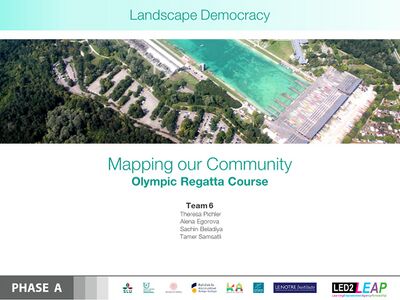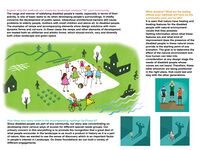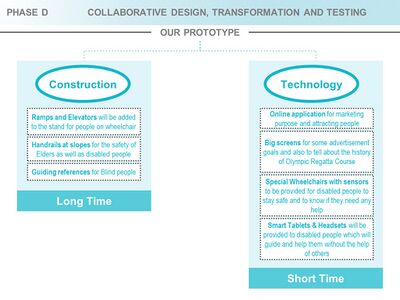LED2LEAP 2020 - Freising Team 6
>>>back to working groups overview
| Area | Freising | |
| Place | Olympic Regatta Course | |
| Country | Germany | |
| Topics | Landscape Democracy | |
| Author(s) | Theresa Pichler, Alena Egorova, Sachin Beladiya, Tamer Samsatli | |

| ||
Landscape Democracy Rationale
- Why do you think this community context is relevant from a landscape democracy perspective? What is your hypothesis considering the landscape democracy challenges?
- Format: 3-4 sentences
Location and scope
Phase A: Mapping your Community
Welcome to our community and its landscape
- OLYMPIC REGATTA COURSE is a rowing venue situated in Oberschleißheim near München in Germany. It was built for the rowing and canoeing events of the 1972 Summer Olympics, since then the site has been in active use ever since – for the daily training sessions of the home based Watersport Clubs as well as for big national and international events like the German Championship or the World Rowing Championship in 2007.
- The area is also a popular destination for excursions of hikers, cyclers and inline skaters who can enjoy a day out on the paths around the lake.
- The regatta course area is part of the two communities München and Oberschleißheim.There is mostly agricultural use and forest around the lake. Also it is part of „blue connection“ between Isar and Amper - as you can see in the sketch.
- graphical representations based on our PPT presentation
Groups of actors and stakeholders in our community
- we are showing the actor groups in our area, their visibility and needs
- There are strong & weak relationships and shared interests between the actor groups
- graphical representations based on our PPT presentation
Relationships between our actors and groups
- there are strong & weak relationships and shared interests between different actor groups
- for example tourist groups and restaurants have a strong relationship. On the other hand there is a weak relationship between tourist groups and researchers
- shared interests you can see between locals and farmers
- graphical representations based on our PPT presentation
Summary of your learnings from the transnational discussion panel on April 22
On April 22 you will present the PPT version of this first assignment to other seminar groups working in other geographical community contexts. Please give here a short summary of your learnings during this presentation, for example:
- importance of community participation
- Other analytical approaches
- time management is an essential component of presentations
- Other representation styles
- we received Constructive comments on our presentation
Theory reflection
- Insurgent Public Space
public space is where identities, meanings, and social relationships in cities are produced, codified, and maintained, it is through insurgent public space that alternative identities, meanings, and relationships can be nurtured, articulated, and enacted. better understand such everyday and not-so-everyday making of public space that defies the conventional rules, regulations, and wisdom. It focuses on alternative spaces, activities, expressions, and relationships that have emerged in response to opportunities, constraints, and transformation in contemporary society.
- Storytelling, a model of and a model for planning
It was obvious that old stories could be the base that we should keep an eye on and try to build our new vision by taking into consideration that the development of our stories. The development of any future landscapes must stick to past stories and put forward a proper study for the existance situation of any rigion.
References
- Header graphic: https://www.leistungszentrum-muenchen.de/ueber-uns/anfahrtsplan/
- Figure 1:https://account.mapbox.com(edited with Photoshop)
- Figure 2: own illustration based on: https://account.mapbox.com
- Figure 3: https://www.umweltatlas.bayern.de/mapapps/resources/apps/lfu_natur_ftz/index.html?lang=de(Umweltatlas Bayern)
- Figure 4: https://www.citypopulation.de/en/germany/bayern/
- https://www.citypopulation.de/en/germany/bayern/
- https://en.wikipedia.org/wiki/Oberschlei%C3%9Fheim_Regatta_Course
- 6th LE:NOTRE institute Landscape forum 2017: https://www.landscape-portal.org/
- Own survey
Phase B: Democratic Landscape Analysis and Assessment
The Scene in Story of Analysis
- Maybe our area-Regatta Course has lots of potentials and famous for its beautiful nature, but on the other hand,
during the researches and regarding the feedbacks that we collect from users in our area are lack with important arrangements for disabled people.
- We think that those people do not have the same chances to be involved in daily life activities as non-disabled.
- Therefore, they deserve to have easy access to Regatta and also to make like a shift that equalizes access and better the community in that region.
- So the ideal is that everyone has a say in the direction of our future.
The Actors in Story of Analysis
- We Highlighted The Disabled People With Special Needs Because their Voices are Not Heard.
- In the pictures we have explained the current issues of every actor.
The Story of Analysis
- The story of our Actors (Disabled people) start when their requirements in Regatta were not heard and they decided to create like a platform to share their interests and needs to provide them with easy access that could motivate them to stick to Regatta Course.
- Here we tried to present our story with our actors that we already chose as you see in our slides.
Reflect on Story of Analysis
- Here we tried to sum up and talk briefly that if everything ended well and the voices of disabled people were heard and they got what they dream about,
this could least no only for one year but also it will remain for decades.
- We think that the methods that we chose can refer and respond to what are missed in some landscape issues and maybe every authority and designer should take into account that all people are equal and they all have the same rights.
Phase C: Collaborative Visioning and Goal Setting
The Scene in our Story of Visioning
- As mentioned before in our previous phase the Olympic Regatta Course had a different number of challenges and those problems are somehow related to the way we deal with persuading more accessibility to this area. Some of these challenges are lack of public transport, lack of accessibility for disabled people, and also missing some information boards that help the tourists to know more about the Regatta. Therefore, the appropriate statement that could fit our area with all its challenges is the INTERVENTION FOR SAFE AND EASY ACCESS FOR EVERY CAPITA.
The Actors in our Story of Visioning
- In regards to help in the intervention of any future vision and in the execution of a proper plan, we need some effective characters who can implement these goals into reality. For that reason, our new actors who have been added to our story are implementers and have the power to make a change. The first add was by presenting the new ARCHITECT “Mattias” and his colleague “TOM”, while the second edit was to present the “MAYOR” of Oberschleißheim “Markus Böck” and his Construction Director “Eberhard Schmid”.
The Story of Visioning
- A council meeting was made by the mayor of Oberschleißheim in order to discuss the challenges of the Regatta Course and also to put forward some effective solutions that have the ability to develop the area. Three main goals were the conclusion of the meeting and they can be mentioned as follow; 1- Barrier-free design, 2- The development of touristic infrastructure, 3- the intervention of public transport.
- To make a difference in any development, goals should be followed by any actions. For instance, actions for Barrier-free design could be by adding some sanitary facilities, parking & path network, and also to develop the situation of the stand located in Regatta and add some ramps that could help disabled people to be part of the community and feel equal with other citizens.
- The action plan discussed was for the stand in our Regatta, and the operation of these improvements was planned to be completed in 3 years divided into many important stages starting by the council meeting, doing some proper plans, and ending by the construction phase.
Reflections on our Story of Visioning
- The reflection of the story was formulating goals and having a good vision.
Here are the factors that need to be considered while FORMULATING GOALS and be sure about their characteristics of a GOOD VISION.
Phase D: Collaborative Design, Transformation and Planning
Your Prototyping Action
- What was your prototyping action? What does it represent and how does it relate to your vision from Phase C?
- add the corresponding visual from your presentation to the image gallery below
The Evolution of Your Prototyping Action
- Describe the actors who were working together on this action. What was your collaborative design process? What tools or methods did you use to collaborate?
- add the corresponding visual from your presentation to the image gallery below
The Plan Behind Your Prototyping Action
- What resources, material and human, did you need to realize your action, and how were they used? What roles were created for this action? Additionally, What kind of timeframe was created for executing the plan?
- add the corresponding visual from your presentation to the image gallery below
The Realization of Your Prototyping Action
- What happened, who was there and what was the atmosphere like among the participants?
- add the corresponding visual from your presentation to the image gallery below
Reflect on Your Prototyping Action
- In the end, what change did the intervention create? How would you adjust it to be more effective if you did it again? Consider what it means to be successful, what indicators would you use to measure success in this endeavor? Most importantly, how did your intervention reflect the material in the Phase D lectures?
- add the corresponding visual from your presentation to the image gallery below
Phase E: Collaborative Evaluation and Future Agendas
Collaborative Evaluation and Landscape Democracy Reflection
- First, our focus was to mention the Initial LD challenge stated by the Living Lab as well as to highlight the sustainable goals. To add more, Community Contribution was a good addition to talk about in order to make good and proper modifications. For instance, the community provided us with information about the challenges and suggestions to improve the accessibility to Regatta, and also their interaction through social media was seen obviously. While our work in this process was to play the coordination role between the city council and the regatta community.’'
The Actors in your Collaborative Evaluation
- ’' In this part we concentrate on representing our actors with a small evaluation for everyone which could help us to tackle similar problems in the future. Therefore, our prototype came to help people for finding solutions for their concerns. If we have the opportunity in the future for other changes, we think that engaging with a person from Authority who has the right power to make an immediate decision about any alteration and also to add more participants on the ground is fundamental.
Reflection of the Online Seminar
- ’'Our teamwork was to Explore new ways of interaction with the community because of the Covide-19 pandemic. The teaching, learning methods, and the assignments were coherent and in the right sequence to arrive at solution’'
Reflection of the Living Lab Process
- ’' In order to get some reactions and outputs, some inputs should be added to this process irrespective of any judgment. For instance, the attention of the authority for the community was a critical thing that we persuade to make a difference, as well as the engagement of people with special needs in the whole story. Therefore, outcomes are important for the entire community’'
Your Living Lab Code of Conduct
- ’’ In this part and while addressing a landscape democracy challenge, we found out some useful values which were seen obviously in a Better understanding of a community, Evaluation of every step to make progress, Identification of decision-makers to be placed in the right position, Time scheduling of the whole process and storytelling at the end helped us in the change-making.
Also, some important steps and actions for Living Lab were taken into account, for example, we can mention some like - Experimentation with a solution and implementation of user's feedback - Modification and clarification of the best solutions should be taken into account, - Spread out the experiment overseas to be a good example to follow in future.’’
Process Reflection
- As a team each individual was thinking of a value that we can work within our living lab. Therefore every one of us suggested some values that in his/her point of view are essential or important to stick with during the whole change-making process.
For example, one person thought about the importance of public involvement and more respect for people with special needs, others thought about equality and different activities for different stakeholders. Cultural heritage places, attention to details, open and healthy nature, and welcoming to everyone were also proper value additions suggested by others. Nevertheless, our team came to generally shared core values that we can concentrate on during the process of change-making for the intervention for safe and easy access. Those values were divided into six categories like responsibility, excellence, customers (stakeholders/users), innovation, trust, and ethics. To sum up, top Ground Rules should be considered also in future to Ensure an Inclusive Landscape Democracy Process. Therefore, PUBLIC PARTICIPATION IN THE WHOLE PROCESS was the main concern for us as a team to follow in our next storytelling that could improve the process positively. That's why a good illustration of this viewpoint was added to tell more about the steps needed to achieve this goal in the future.

























































